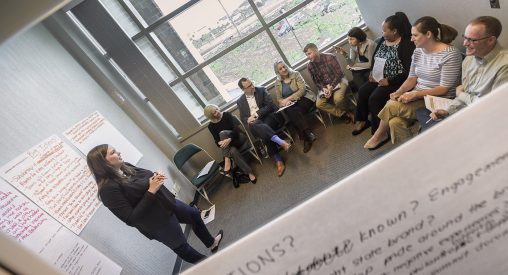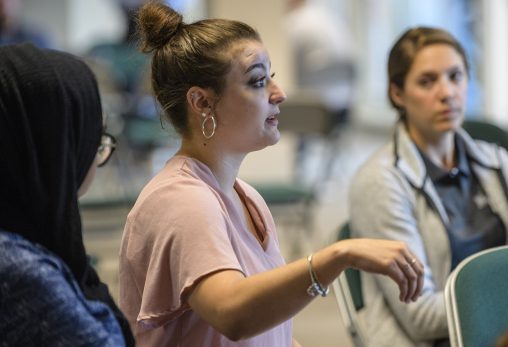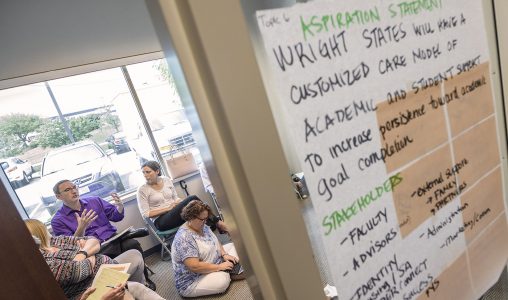
Faculty, staff, students, alumni and community partners gathered together at the mini-summit to propose and evaluate potential projects and activities that could have high impact on Wright State. (Photos by Erin Pence)
Some were huddled in chairs … others on the floor … and still others were standing in doorways leaning in to join in the many conversations that will evolve into Wright State University’s next strategic plan.
Sharing … explaining … listening … ideas building one on another.
Hundreds of large sheets of paper, scribbled with ideas, were a fitting backdrop for the university’s third strategic planning mini-summit on June 22.
Approximately 150 faculty, staff, students, alumni and community partners gathered together to propose and evaluate potential projects and activities that could have high impact on Wright State.
Doug Fecher, chair of the Wright State Board of Trustees and CEO of the Wright-Patt Credit Union, challenged participants to think radically.
“If you think you’ve reached the boundary of where this university can go, then push past it,” he said. “We need to think about ways of serving our students that just flat out haven’t been thought of before.”
Fecher explained that the board is not looking for a strategic plan for today’s world of higher education, but rather one that invents a university of tomorrow because the environment of higher education has changed so markedly.
“Let’s really push the boundaries to get a plan that is different than anybody would see at another university,” he said.

Gloria Pappaterra, a political science and sign language interpreting student, offered suggestions and a student perspective to the Community, Diversity and Globalization working group.
Participants have formed working groups for each of the 15 strategic initiatives organized around the themes of collaborative delivery of services; research, innovation and entrepreneurship; strategic relationships and partnerships; teaching, learning and programming; and the Wright State experience.
During the mini-summit, each of the working groups explored the proposed projects, outlined the scope of activities and the potential benefits. They also began preparing for July’s mini-summit when community members will evaluate each project in more detail through an “idea marketplace.”
“As a student, I feel my voice is being heard,” said Gloria Pappaterra, a political science and sign language interpreting student. “I think the university is moving forward in a way that is gong to be more inclusive and accessible for all students.”
Pappaterra, who has been participating in the Community, Diversity and Globalization working group, said this experience has made her feel more valued.
Ideas were flowing freely at the summit. A few of the many ideas included: creating an Experiential Learning Hub that is collaborative among units on campus, having a variety of class delivery methods to make classes and materials more accessible, creating a central committee to facilitate more collaboration in inclusion and diversity efforts, ensuring collaborative delivery of academic support services, and creating an e-campus with more online courses and services.
“I think we’ve come a long way,” said Wright State President Cheryl B. Schrader. “It’s great to see some very bold ideas coming forward.”
The next mini-summit on July 13 is being billed as an “idea marketplace,” where participants can visit each of the 15 strategic group “storefronts” and select a limited number of ideas that they “buy in to.” Groups will then review feedback and decide which of the ideas they want to continue pursuing.
Future mini-summits are planned for:
July 13: Session 4: Evaluate and Prioritize Actions
August 3: Session 5: Identify Metrics, Resources and Milestones
August 31: Session 6: Assemble the Strategic Plan
There is still opportunity to join the strategic planning process. RSVP through the strategic planning website. Sessions will be held from 8:30 a.m. to noon in the first-floor gallery space at 2455 Presidential Drive.

During the June 22 mini-summit, the strategic initiative working groups explored proposed projects and potential benefits to Wright State.
Through the strategic planning process, the university is creating an ongoing dialogue that encourages continuous reflection and revision of the community’s hopes and priorities. The planning process is designed to help faculty, staff and students engage and reconnect with others across the university and with partners in the broader community in meaningful ways. Over time, this process will help the Wright State community shape both its culture and future.
The new strategic plan will guide Wright State University by creating a vision and focus that directly aligns resources with the community’s values, strengths and the strategy built around them. The planning process will put the institution in a position to thrive in higher education’s changing environment, help the university achieve financial sustainability, and foster a campus atmosphere that provides graduates with opportunities to excel in fields that define the future.

 Milling around
Milling around  Wright State recognizes Nursing Professor Kim Ringo for advancing international student success
Wright State recognizes Nursing Professor Kim Ringo for advancing international student success  Wright State honors graduating students for distinguished doctoral dissertations
Wright State honors graduating students for distinguished doctoral dissertations  Top 10 Newsroom videos of 2025
Top 10 Newsroom videos of 2025  Museum-quality replica of historic Hawthorn Hill donated to Wright State
Museum-quality replica of historic Hawthorn Hill donated to Wright State 